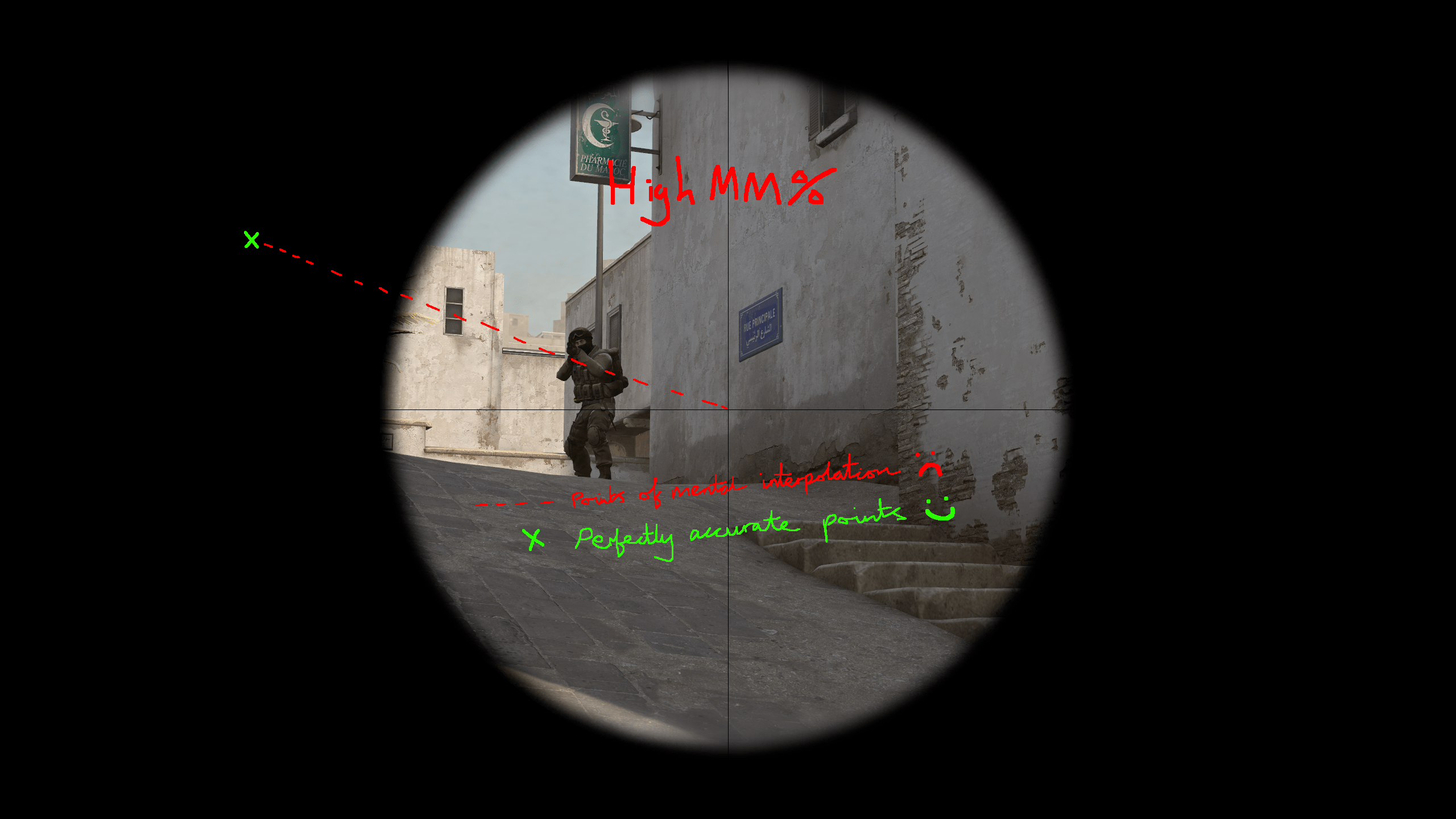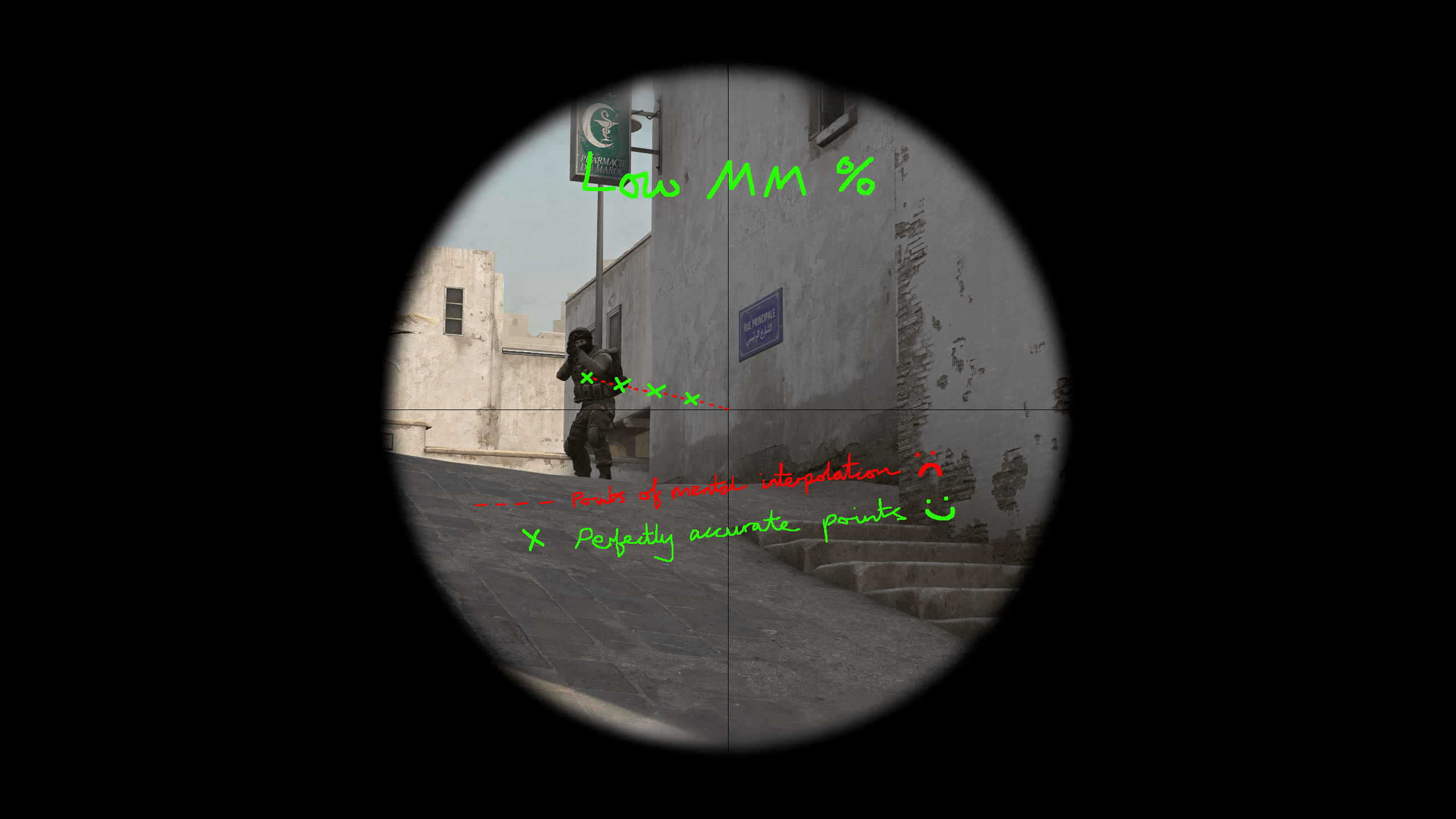Converting between games sensitivities can be confusing, and critical for maintaining muscle memory for FPS shooters, here’s a deep dive into how.
Most of this content is based off an article I wrote for Mouse-Sensitivity a few years back and a few new adjustments for my blog.
Why is this not simple?
When playing a 3D game, the information is displayed through a 2D monitor. We encounter the same problem cartographers had many years ago, how do you map a sphere onto a flat surface without distortion? You can’t! However, there are different approaches that cut your losses in different places.
3D Games generally use Gnomonic projection where a light is placed in the centre of the sphere, and is then the image is shadowed to a plane touching the sphere at one point. This works for FOVs < 180° which is fine for FPS games since you only care about what is in front of you.
This creates distortion at the edges of the image as rays that get closer to the max FOV of 180° get put really far away on the plane so angles on your screen are not preserved for different FOVs (i.e. halfway between your screen and the edge on a 90° FOV isn’t 45° in game) what this means is that when you have two different FOVs there will not be two respective sensitivities that match everywhere. This has lead to many methods of converting sensitivities that all have their pros and cons as there is no perfect conversion.
Conversion Methods:
360° distance
This is the method most people think of when wanting to convert sensitivity, and is the one people usually try do themselves with some paper and a ruler. Measuring the distance your mouse moves to turn 360° in game and matching this distance with the other game so the mouse moves the same amount.
This method matches angles around you in 3D space. So for example every 360° swipe will be the same, and every 180° behind you onto a target will be the same. This is good for general spacial awareness if you know someone’s behind you etc… but it is good for not much else.
Plus if you know someone’s behind you the other methods you will soon see will put you in the right ball park anyway (unless the FOV is very different) and then you can aim more accurately with those other methods.
Consider a scoped weapon, i.e. a very small FOV and then your normal FOV. You would not want to be able to do a 360° in the same distance, or you wouldn’t be able to aim at all.
This method will only really work if the FOV is exactly the same across the games (but every conversion method would give you the same value anyway) or you’re into general spacial awareness, I give that as a pro of the method but not the sole reason to use it.
Monitor Distance
This method matches your sensitivity perfectly for a specific point(s) on your monitor. You can imagine a ring around your crosshair where it matches1. Why is this better than 360° distance? Well when you aim at something, your mind doesn’t calculate the angle between you and your target and then aim that much angle, instead we’re more bound by how much distance there is on the screen between our crosshair and them. This means you may not be accurate turning around 180° but you’ll be more accurate for the targets on your screen around where you’ve set your perfectly matched ‘ring’ up. This is good as you’ll be better aiming at targets on your screen over different FOVs and also, due to using it matching distance on your monitor, we can use it to convert both hipfire sensitivity and ADS sensitivity whereas 360° distance matching wouldn’t have worked for ADS.
Well where is this ‘ring’ then?
You may ask, well we get to choose. We will pick a ratio between the centre and an edge of our screen ranging from 0% to 100% (e.g. 50% is directly between your crosshair and the edge of your monitor).
There are two types of monitor distance matching: vertical and horizontal. One matches 100% to the top of your monitor, and the other matches 100% to the sides of your monitor. There is an equivelence between these assuming the scaling between your verical and horizontal sensitivity is equivalent.
To convert 100% vertical monitor match to horizontal monitor match on a 16:9 montior we would do the following calculation $ 100\% \cdot (9/16) = 56.25\% $
To convert 30% horizontal monitor match to vertical monitor match on a 4:3 montior we would do the following calculation $ 30\% \cdot (4/3) = 40\% $
So what is the best match percentage?
This has been of much debate in communities who care about getting the best conversion, and I guess will continue to be as people have different opinions and so I’ll try give you it as unbiased as possible.
Because of the match only being correct on a certain ring, it must be incorrect not on that ring. As it happens, it will feel too fast inside the ring, and too slow outside (assuming you’re converting hipfire to a scope, otherwise vice versa). Since 90% of your aiming that you want to get right is typically close to the crosshair, your want your match to be close to the crosshair. This corresponds to between 0% - 50% vertical monitor match. Vertical chosen since it’s more consistent across ultrawide monitors.
You can see this in the following video, where green is the ‘Goldilocks zone’, blue is the perceived sensitivity is too fast, and red is the perceived sensitivity is too slow:
The best ratio to hold up mathematically is 0% and should probably be under it’s own name. You may hear it called ‘zoom ratio’ instead but I’ll keep it with this section for sake of simplicity. This is the best I’ve tried after I’ve gotten used to it.
Every other % match is essentially just arbitrary change in sensitivity that may happen to be close to preference, and if you chose it it’s down to personal preference, for example:
100% 4:3 horizontal monitor distance match (75% 16:9 horizontal monitor distance match equivelantly) is what CS:GO use for their scoped sensitivity conversions so if you’ve gotten used to this and you’re some pro legendary AWP-er, this might be the way to go for you when converting in other games.
If you do a lot of flick shots maybe you want to go closer to 50% vertical monitor match, at the expense of accuracy at the crosshair.
One thing to bare in mind when using anything other than 0%, everything around the crosshair not on your not on your match ratio is essentially not matching at all and your mind is interpolating the sensitivity, so muscle memory will take longer to build but with 0% you’re muscle memory is at the crosshair, so things like micro adjustments when making a big flick (which is what happens in every flick, you’re not perfect), and controlling recoil back onto someones head is perfectly matched across all FOV’s and this is the massive advantage of low % matches. Hopefully the following images make this clear:


-
This is approximately true, when looking at the horizon, but otherwise the ring won’t be a perfect circle. However I will continue to use this ring analogy for explanatory power. ↩︎